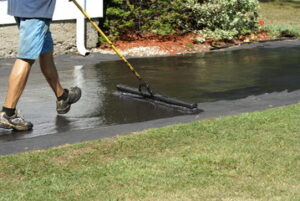Having a beautiful driveway adds to the curb appeal of your home. But maintaining that pristine appearance requires more than just regular cleaning. You need to make sure it is adequately sealed.

Concrete sealer fills in concrete pores, protecting it from moisture that can damage it over time. It also helps prevent potholes from forming. Visit https://www.rochesternysealcoating.com to learn more.
A clean, pristine driveway adds curb appeal and value to a home. Unfortunately, many homeowners neglect to keep up with the maintenance that their asphalt or concrete driveway requires. Regular sealing is a crucial step in maintaining that pristine look. However, it is not a project that should be taken on as a DIY endeavor. Instead, hiring a professional can ensure that the job is done properly and your driveway is protected from the elements for years to come.
Before the sealant is applied, the driveway should be swept thoroughly and power-washed. This will remove any dirt, debris or moss that may have settled on the surface and prevent the sealant from bonding well. The edges of the driveway should be trimmed and any weeds pulled. This is important because weeds can grow through the sealant and ruin the finished appearance of your driveway.
Once the driveway is cleaned, it is important to allow it to dry completely before starting on the application process. The sealant should be mixed per the manufacturer’s instructions. Different sealants have different formulations and some are designed for newer or well-maintained driveways while others are designed for older, less-maintained pavement. It is also a good idea to purchase one container more of sealant than you think you will need, so that you have plenty of extra in case you need to touch up any areas.
During the sealant application process, it is a good idea to work from the middle of the driveway and move outward. This will help you avoid running out of sealant near the edge of your driveway and will create a smooth, even coat that will last longer. It is also a good idea to follow the manufacturer’s directions regarding how much sealant to apply.
If your driveway has any cracks, it is a good idea to use a crack sealer prior to applying the sealant. This will help fill in any small cracks and help your driveway look its best when you are done. A quality sealant should last about three to five years, depending on how much you use it.
Applying the Sealer
During the application of a sealer, driveways are protected from damage by a protective barrier. A sealcoat, made of heated asphalt bitumen or latex, is poured over the surface of the concrete or blacktop to create a layer that prevents water from penetrating the driveway and causing damage. The resulting smooth surface is similar to a fresh coat of paint or a spa day for your driveway, renewing and revitalizing its appearance.
It is recommended to use a professional to apply the sealer, as the job requires a high-powered pump and extensive experience. While it may be possible for a homeowner to do the job themselves, there is a significant risk of applying too little or too much sealant, which can result in the failure of the project.
Prior to beginning the process, it’s important to carefully read the label and manufacturer recommendations for determining how much sealant will be needed to cover your driveway. It’s also helpful to measure the size of your driveway to get a better understanding of how much material will be required. Once the amount of sealer has been determined, the preparation of the surface can begin. It’s best to start at one end of the driveway and work your way across, so that you have an even coating.
To prepare the surface for sealer, sweep away leaves, acorns and other debris from the surface. If there are weeds growing, pull them or use a degreaser to remove them from the driveway before sealing. For oil or gas stains, scrub the spots with a stiff-bristled brush and specialized cleaner to make sure that they’re completely removed and will not reappear after the sealant has been applied.
Once you’re ready to apply the sealant, begin in one corner of your driveway and pour a ribbon of material across the width of your driveway. Work quickly to ensure that the area is coated evenly. Using the brush side of the applicator or a floor squeegee, push and pull the asphalt to distribute the material evenly. Continue this process until the entire surface of your driveway is covered, then let it dry according to the manufacturer’s instructions.
Drying Time
It’s important to allow the sealant to fully dry before driving or parking on it. This allows it to cure properly and create a protective barrier that blocks out UV rays, moisture and other substances that can damage asphalt or concrete over time. The exact amount of time it takes for the sealant to fully cure varies depending on the type of product used, the weather conditions and other factors.
It can take anywhere from 24 to 48 hours for a driveway to be able to support the weight of cars and other vehicles after it’s been sealed. If you do try to test the sealant by driving on it early, the full weight of the car can cause the surface to deteriorate or bubble, and your driveway will not last as long as it should.
To reduce drying times, it’s important to choose a quality product that will work well in your climate and the condition of your driveway. Some sealants are thicker and slower to dry, while others are thinner and quicker-drying. When selecting a product, look at the manufacturer’s specifications and reviews to find one that works best for your needs.
When applying the sealant, it’s important to follow all of the manufacturer’s instructions. You can use a rubber squeegee or broom to spread the sealant, but it’s best to use a wide paintbrush for detailed areas that require more attention. It’s also a good idea to mask off areas you don’t want to coat with plastic sheeting or drop cloths, just like you would when painting.
After you’ve applied the first coat of sealant, wait eight hours for it to dry completely before proceeding with another application if necessary. You may need to apply two or more coats for your driveway to achieve the desired appearance and protection. For the best results, it’s important to apply sealant when temperatures are above 50 degrees Fahrenheit.
To reduce your chances of running out of sealant before you’re finished, consider purchasing a few more containers than you estimate you need. This way, you can save a container for touch-ups and have enough on hand to ensure that your driveway looks beautiful when it’s finished.
Safety
A driveway that is properly sealed will protect it from water damage, UV rays and the oxidation of the asphalt. This will also help to keep it looking nice and can even add to the resale value of your home. Replacing a driveway is expensive, so it is important to keep up with the maintenance.
In addition to the obvious benefits of a clean appearance, sealing your driveway will help prevent oil, gas and other vehicle fluids from seeping into and damaging the asphalt. It will also help to prevent dirt, ice and other debris from getting into and scratching the surface.
A good rule of thumb is to have your driveway seal coated every three years, but this varies depending on the location and weather conditions. If you notice that your asphalt is starting to look faded, this is a sign that it is time for a new coat of sealant. The appearance of fine cracks is another good indicator that it is time to re-seal your driveway.
The first thing that you will need to do is clear your driveway of any debris, including leaves and grass clippings. You will also need to wash away any stains or spots on the asphalt surface. Make sure to turn off any sprinklers a day before the sealcoating process starts, as they will need to be turned off until after the sealant has dried.
It is important to wear rubber gloves and a mask when working with the sealant, as it can be very harmful if it comes into contact with your skin or if you breathe in its strong odor. It is also important to only work on your driveway when the weather is warm and sunny. If it is too cold or wet, the sealant will not set up correctly and may eventually fail.
One common mistake that homeowners often make is to recoat their driveway too frequently. While resealing can help to prolong the life of an asphalt driveway, it is not effective when the original material has deteriorated to the point where large cracks are prevalent.
